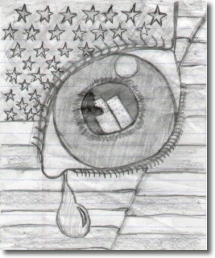
Addressing students' questions in the aftermath of the terrorist attacks
 |
Addressing students' questions in the aftermath of the terrorist attacks
|
Objective
To promote the idea of peacemaking and nonviolence in government foreign policy. To distinguish between punitive and restorative justice. To allow students to think "outside the might-makes-right" paradigm, reflecting the mission statement of peace education for the Nuclear Age Peace Foundation.
| Activities In light of the recent terrorist attacks, many teachers may be wondering what kinds of exercises or points of discussion to use with students. Some ideas are the following: 1. Ask students what the immediate needs are of the families and friends of those killed or missing in New York and Washington, DC. Suggested responses are: comfort, structure, reassurance, financial help, grief counseling, etc. 2. Ask students what has been helpful when they have experienced loss, for example a death in the family, breaking up with a significant other, moving to another city or having someone close to them move, etc. |
 |
3. Ask students what has not been helpful to them. Have them explore the things which did not comfort them that other people offered while they were grieving.
4. Discuss the two types of justice, restorative and punitive. Restorative justice, in the Gandhian sense, seeks to restore the guilty person to a whole human being, and punishment is both meaningful and creative. Restorative justice does not mean overlooking a wrong or pretending it did not happen, but rather it means that the person who committed the wrong is not humiliated nor deprived of his/her humanity. Restorative justice focuses on reconciliation and making as much good as possible come from the wrong that was done. On the other hand, punitive justice tends to be heavy-handed and separates the wrong-doer from the victim, and rather than allowing the crime to exist between two individuals, the crime now belongs to the “State”. It emphasizes humiliation, detachment from other people and even death through execution in severe cases. Gandhi once said that the goal was not to bring the enemy to his knees but to his senses. Restorative justice seeks to bring our enemies to their senses. Punitive justice seeks to bring them to their knees.
5. Ask students how the situations in New York and Washington, DC can be made as right as possible. Ask what the greatest amount of good could emerge from this situation. “If your students ruled the world…” how would they create the greatest amount of good?
6. Have students brainstorm ideas for how families, children, and friends of those killed and/or missing could best express their confusion and anger resulting from these events. Have your students brainstorm ways they can deal with their own confusion and anger. Remind them that nonviolence emphasizes creativity and compassion.
7. Have students brainstorm ideas about nonviolent ways to prevent these types of incidents from happening again. How can we promote cross-cultural dialogue and dispel some of the ideas promoted in the mass media about people from other parts of the world?
© 2002 by Nuclear Age Peace Foundation -
WagingPeace.org
|
|
|||||||
|
home • schools • top 10 actions • about us |
|||||||
copyright © www.worldpeace.org.au 2001-2025
 |
|
 |